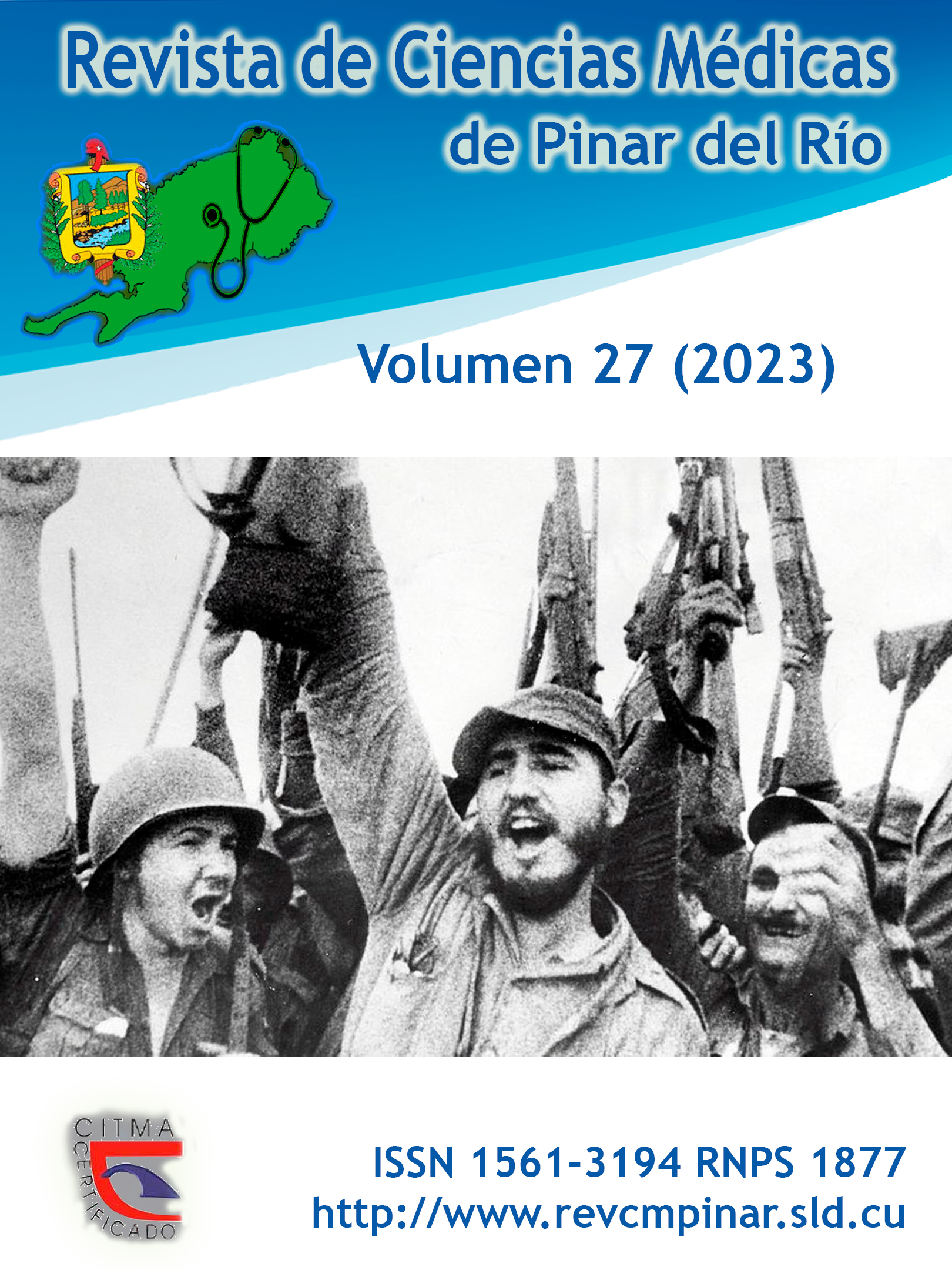Biosafety in Dentistry before and during the COVID-19 pandemic
Keywords:
CONTAINMENT OF BIOHAZARDS, COVID-19, DENTISTRY.Abstract
Introduction: in the case of dentistry, biosafety focuses on the procedures that’s hould be followed within the dental office in order to ensure the health and safety of both the dentist and his assistants, as well as the patient. These biosafety procedures in dentistry involve immunization strategies and also the prevention of exposure of dentists, assistants and patients to infectious materials.
Objective: to describe the changes in biosafety measures in dentistry worldwide determined by the detection of the SARS-CoV-2 virus.
Methods: to carry out this research, 27 articles were consulted on the subject obtained from searches in databases such as Elsevier through Science Direct, Google Scholar and Scielo, of which 14 as a bibliography, with a predominance of articles published during the last five years and others due to their relevance.
Development: biosafety protocols before the appearance of Covid-19 were focused on avoiding occupational accidents, occupational diseases and cross-infections. Hand washing was widespread among health professionals and was not very common among the general population. After the detection of Covid-19, cleaning and biosafety conditions within the dental practice were improved, more informed patients, effective cleaning staff, mandatory hand washing rules, temperature taking, instruments for each patient, strict sterilization rules and general cleaning of areas.
Conclusions: before performing a treatment the patients hould rinse the mouth for one minute with hydrogen peroxide at 0,5 % -1 % (be careful when preparing it to avoid mucosal burns) or with Povidone at 0,2 % (be careful with those allergic to iodine).
Downloads
References
1. Serrano-Cumplido A, Antón-Eguía Ortega PB, Ruiz García A, Olmo Quintana V, Segura Fragoso A, Barquilla Garcia A, et al. COVID-19. La historia se repite y seguimos tropezando con la misma piedra. Semergen [Internet]. Agosto 2020 [citado 17/10/2022]; 46:48-54. Disponible en: https://www.ncbi.nlm.nih.gov/pmc/articles/PMC7303648/
2. Deana NF, Zaror C, Seiffert A, Aravena-rivas Y, Muñoz-millán P, Espinoza-espinoza G, et al. QUALITY APPRAISAL OF CLINICAL PRACTICE GUIDELINES ON PROVISION OF DENTAL SERVICES DURING THE FIRST MONTHS OF THE COVID-19 PANDEMIC. Journal of EvidenceBased Dental Practice [Internet]. 2021 [citado 12/10/2022]; 21(4):101633. Disponible en: https://www.sciencedirect.com/science/article/pii/S1532338221001081
3. Martín Carreras-Presas C, Aranguren J, Baracco B, De La AL, Juan López-Quiles M, Montero Martínez A. Proto-covid Protocolo de prevención en la clínica dental frente al covid-19 [Internet]. COEM; 2020. [Citado 09/02/2022]. Disponible en: https://coem.org.es/media/news/pdf/Proto-Covid-COEM.pdf
4. Boin-Bakit C, Melián-Rivas A, Boin-Bakit C, Melián-Rivas A. La atención Odontológica a Pacientes COVID-19 Positivo ¿Qué hacer ante una Urgencia? International journal of odontostomatology [Internet]. Septiembre de 2020 [citado 21/09/2022]; 14(3):321-4. Disponible en: http://www.scielo.cl/scielo.php?script=sci_abstract&pid=S0718-381X2020000300321&lng=es&nrm=iso&tlng=es
5. Ordoñez AEB, Duche NPV, Benítez PGM, Vanegas JDQ, Merizalde YMY. Protocolos de atención odontológica ante la nueva realidad por COVID-19. RECIAMUC [Internet]. 31 de enero de 2021 [citado 27/10/2022];5(1):211-22. Disponible en: https://reciamuc.com/index.php/RECIAMUC/article/view/606
6. Ushiña V, Barzallo M, Flores I, Sánchez S, Zurita JC, Luna D. Protocolo para atención odontológica en emergencias y urgencias odontológicas durante la emergencia sanitaria por COVID -19 [Internet]. Gob.ec.2020. [citado el 12/02/2022]. Disponible en:https://www.salud.gob.ec/wp-content/uploads/2020/04/PROTOCOLO-PARA-ATENCI%C3%93N-ODONTOL%C3%93GICA-EN-EMERGENCIAS-Y-URGENCIAS-ODONTOL%C3%93GICAS-DURANTE-LA-EMERGENCIA-SANITARIA-POR-COVID-19.pdf
7. Page MJ, McKenzie JE, Bossuyt PM, Boutron I, Hoffmann TC, Mulrow CD, et al. The PRISMA 2020 statement: an updated guideline for reporting systematic reviews. BMJ [Internet]. 29 de marzo de 2021 [citado 02/11/2022]; 372(71). Disponible en: https://pubmed.ncbi.nlm.nih.gov/33782057/
8. Blanco D. MANUAL DE BIOSEGURIDAD PARA CONSULTORIO ODONTOLOGICO AUTOR [Internet]. Universidad Militar Nueva Granada; 2016. [citado 08/02/2022]. Disponible en: https://repository.unimilitar.edu.co/bitstream/handle/10654/14870/BLANCOVENTURADAYILIS.pdf;jsessionid=07D31C4547D8536010FAFEE0A83A3F0C?sequence=1
9. Pérez R, Luna C, Tapia D. Manual de Bioseguridad- División Estomatología-Ortodoncia [Internet]. Gob.mx; 2020[citado 09/02/2022]. Disponible en: https://www.gob.mx/cms/uploads/attachment/file/564031/MANUAL_DE_BIOSEGURIDAD_DIV._ESTOMATO-ORTODONCIA.pdf
10. Medina Arizpe SJ, Salinas Noyola A. Lineamientos de bioseguridad utilizados en las clínicas dentales periféricas de la Universidad de Monterrey durante la pandemia de COVID-19. Rev ADM [Internet]. 26 de junio de 2020[citado 09/02/2022];77(3):146-52. Disponible en: https://www.medigraphic.com/cgi-bin/new/resumen.cgi?IDARTICULO=94008
11. Lang H. BIOSEGURIDAD PARA LA ATENCIÓN ODONTOLÓGICA COVID 19 [Internet]. Colegio Higienista; 2021. [Citado 12/02/2022]. Disponible en: https://www.colegiohigienistascv.es/wp-content/uploads/2020/04/PROTOCOLO-DE-BIOSEGURIDAD-pdf.pdf.pdf.pdf
12. Tovar S. Lineamiento de bioseguridad para la prestación de servicios relacionados con la atencion de la salud bucal durante el periodo de la pandemia por Sars-CoV-2 (covid-19). [Internet]. Ministerio de Salud y Protección Social Bogotá; 2020. [citado el 13/02/2022]. Disponible en: https://www.minsalud.gov.co/Ministerio/Institucional/Procesos%20y%20procedimientos/GIPS31.pdf
13. Ather A, Patel B, Ruparel NB, Diogenes A, Hargreaves KM. Coronavirus Disease 19 (COVID-19): Implications for Clinical Dental Care. J Endod [Internet]. Mayo 2020 [citado 20/10/2022]; 46(5): 584-95. Disponible en: https://www.ncbi.nlm.nih.gov/pmc/articles/PMC7270628/
14. Comisión de Control de Normas de Bioseguridad. Protocolos de atención odontológica en contexto de pandemia – COVID 19. Ministerio de Salud. Jujuy[Internet]; 2021. [citado 11/02/2022]. Disponible en: http://salud.jujuy.gob.ar/wp-content/uploads/sites/14/2021/04/PROTOCOLOS-DE-ATENCI%C3%93N-DONTOL%C3%93GICA-COVID-19-Febrero-2021.pdf
15. Manejo de la atención estomatológica en el contexto de la pandemia por Covid-19 [Internet]. Ministerio de Salud-Perú; 2020. [citado 13/02/2022]. Disponible en: https://cdn.www.gob.pe/uploads/document/file/716209/DIRECTIVA_SANITARIA_N_100-MINSA-2020-DGIESP.pdf
Downloads
Published
How to Cite
Issue
Section
License
Authors who have publications with this journal agree to the following terms: Authors will retain their copyrights and grant the journal the right of first publication of their work, which will be publication of their work, which will be simultaneously subject to the Creative Commons Attribution License (CC-BY-NC 4.0) that allows third parties to share the work as long as its author and first publication in this journal are indicated.
Authors may adopt other non-exclusive license agreements for distribution of the published version of the work (e.g.: deposit it in an institutional telematic archive or publish it in a volume). Likewise, and according to the recommendations of the Medical Sciences Editorial (ECIMED), authors must declare in each article their contribution according to the CRediT taxonomy (contributor roles). This taxonomy includes 14 roles, which can be used to represent the tasks typically performed by contributors in scientific academic production. It should be consulted in monograph) whenever initial publication in this journal is indicated. Authors are allowed and encouraged to disseminate their work through the Internet (e.g., in institutional telematic archives or on their web page) before and during the submission process, which may produce interesting exchanges and increase citations of the published work. (See The effect of open access). https://casrai.org/credit/



